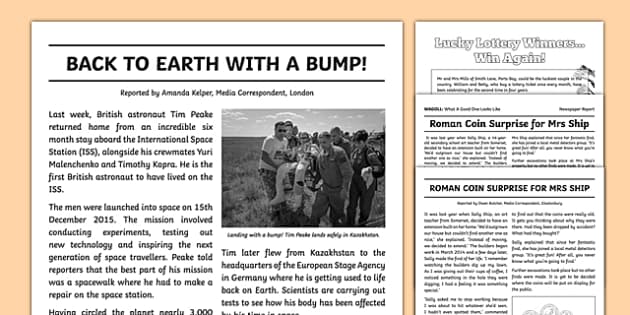4 Easy Facts About News Articles Shown
4 Easy Facts About News Articles Shown
Blog Article
Some Known Factual Statements About News Articles
Table of ContentsThe smart Trick of News Articles That Nobody is Talking AboutNews Articles Fundamentals ExplainedThe 4-Minute Rule for News ArticlesAn Unbiased View of News ArticlesNews Articles - Questions
Great knowledge of various topics provides pupils a competitive side over their peers. Despite the fact that electronic and social media sites are easily accessible, we need to not neglect how vital it is to read the papers. Moms and dads have to attempt and instill the behavior of reviewing a paper as a day-to-day routine to continue the tradition of the revered print medium.News stories likewise have at the very least one of the following crucial attributes relative to the intended target market: closeness, importance, timeliness, human interest, peculiarity, or effect.
Within these limitations, information tales likewise aim to be comprehensive. Other elements are involved, some stylistic and some derived from the media kind. Among the larger and much more reputable papers, justness and equilibrium is a major variable in offering details. Discourse is normally confined to a separate section, though each paper might have a various general slant.
Newspapers with an international audience, as an example, tend to use a more formal style of composing. The certain options made by a news outlet's editor or content board are typically collected in a design guide; usual style guides include the and the US News Design Book. The main goals of information writing can be summed up by the ABCs of journalism: accuracy, brevity, and clarity.
The Greatest Guide To News Articles
Generally, journalists will not utilize a lengthy word when a brief one will certainly do. They make use of subject-verb-object construction and vibrant, active prose (see Grammar). They use narratives, instances and allegories, and they hardly ever rely on generalizations or abstract concepts. Information authors try to prevent utilizing the exact same word greater than when in a paragraph (occasionally called an "resemble" or "word mirror").
Headings in some cases omit the topic (e.g., "Leaps From Watercraft, Catches in Wheel") or verb (e.g., "Feline woman lucky"). A subhead (additionally subhed, sub-headline, subheading, caption, deck or dek) can be either a secondary title under the primary headline, or the heading of a subsection of the article. It is a heading that comes before the primary text, or a team of paragraphs of the primary text.

of a short article subject, informant, or interviewee), it is described as a pulled quotation or pull quote. Extra billboards of any of these types may appear later in the short article (particularly on succeeding pages) to lure additional analysis. Journalistic sites sometimes use animation techniques to swap one signboard for an additional (e.g.
Some Known Details About News Articles
Such billboards are additionally utilized as tips to the article in various other sections of the magazine or website, or as advertisements for the item in various other magazine or sites. Press release of the Swiss federal government. Common framework with title, lead paragraph (summary in vibrant), various other paragraphs (details) and call info.
Example of a hard-lead paragraph NASA is proposing an additional area project. The spending plan demands roughly $10 billion for the task.
An "off-lead" is the second most important front web page information of the day. To "bury the lead" is to start the short article with history information or information of secondary value to the readers, requiring them to review more deeply right into an article than they must have to in order website here to discover the vital factors.
An Unbiased View of News Articles
Typical use is that or 2 sentences each develop their very own paragraph. Reporters usually explain the organization or framework of a newspaper article as an inverted pyramid. The necessary and most intriguing elements of a story are put at the beginning, with supporting info adhering to in order of decreasing value.
It enables individuals to check out a subject to only the depth that their curiosity takes them, and without the imposition of information or nuances that they could think about unimportant, however still making that info readily available to much more interested visitors. The upside down pyramid structure also enables short articles to be trimmed to any arbitrary length during layout, to fit in the room readily available.
Some authors begin their stories with the "1-2-3 lead", yet there are many kinds of lead readily available. A twist can refer to multiple points: The last tale in the news program; a "delighted" story to finish the show.
Longer articles, such as publication cover articles and the items that lead the inside areas of a paper, are understood as. Attribute stories vary from straight news in a number important link of ways.
The 6-Minute Rule for News Articles
The journalist frequently information interactions with interview subjects, making the item much more personal. A function's very first paragraphs usually relate a fascinating moment or event, as in an "anecdotal lead". From the particulars of a person or episode, its sight promptly widens to generalities regarding the story's topic. The section that signals what a function is about is called the or signboard.

The Editor's Toolbox: A Reference Guide for Beginners and Professionals (2001) Allan M. Siegal and William G. Connolly. The New York City Times Handbook of Design and Usage: The Authorities Style Overview Used by the Writers and Editors of the Globe's Many Reliable Newspaper (2002) M. L. Stein, Susan Paterno, and R.
Report this page